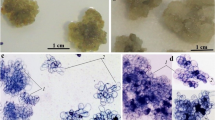Abstract
In vitro growth of Actinidia deliciosa C.F. Liang, cv Hayward and changes in mineral composition of the medium and in the different parts of the explants (callus, stem and leaves), were analyzed after 0, 15, 30, 45 and 60 days of culturing in each of three successive 60 days subcultures.
Fresh (FW) and dry weight (DW) of the explants increased mainly during the first 30 days of culturing, with a predominant increase of FW in leaves and an equal distribution in DW in callus and leaves. Stem FW and DW changes were lower than those observed with callus and leaves. As FW and DW of the explants increased the FW and DW of the medium decreased.
The presence of the explants induced a large decrease of medium pH during the first 15 days of culturing followed by a return to the initial level at the end of the culturing.
The initial P content of the MS medium was insufficient for the long term culturing, as after 30 days of culturing almost all (94.5%) the P present in the medium was absorbed by the explants and evenly distributed in their different parts. During the first month, 85% of the initial N was absorbed. At the end of the culture only 2% of the initial P and 5% of N remained in the medium. These two elements were equally distributed in callus and leaves during the first month of culturing, while in the last 30 days they increased only in the callus.
MS medium initial concentrations of K, Mg, Ca, Fe, Zn, Mn and Cu were sufficient for 60 days explants growth. Almost all these elements were absorbed during the first 30 days of culturing. Their distribution in the different parts of the explant was uneven throughout the culture period. Callus tissue was the main site for accumulation of all these mineral elements.
Similar content being viewed by others
References
Bremner JM & Mulvaney CS (1982) Total nitrogen. In: Page AL (Ed) Methods of Soil Analysis. Agronomy 9, Part 2 (pp 595–624). Am. Soc. Agron., Inc., Soil Sci. Soc., In., Madison
Buiatti M (1983) Colture in vitro e miglioramento genetico. Agricolt. Ital. 3/4: 41–49
Daguin F & Letouze R (1985) Relations entre hypolignification et etat vitreux chez Salix babylonica en culture in vitro. Role de la nutrition ammoniacale. Can. J. Bot. 63: 324–326
Infante R, Magnanini E & Righetti B (1989) The role of light and CO2 - in optimizing the conditions for shoot proliferation of Actinidia deliciosa in vitro. Physiol. Plant. 77: 191–195
McCown BH & Sellmer JC (1987) General media and vessel suitable for woody plant culture. In: Bonga JM & Durzan DJ (Eds) Cell and Tissue Culture in Forestry, Vol 1 (pp 4–16). Kluwer Academic Publishers, Dordrecht, The Netherlands
Mulder EG (1956) Effect of the mineral nutrition of potato plants on the biochemistry and the physiology of the tubers. Neth. J. Agric. Sci. 4: 333–356
Murashige T & Skoog F (1962) A revised medium for rapid growth and bioassays with tobacco tissue cultures. Physiol. Plant. 15: 473–497
Pasqualetto PL, Zimmerman RH & Fordham I (1988) The influence of K+, Mg+ and gelling agent concentrations on vitrification of apple cultivars in vitro. Plant Cell Tiss. Org. Cult. 14: 31–40
Sha L, McCown BH & Peterson LA (1985) Occurence and cause of shoot-tip necrosis in shoot cultures. J. Am. Soc. Hortic. Sci. 110: 631–634
Singha S, Oberly GH & Townsend EC (1987) Changes in nutrient composition and pH of the culture medium during in vitro shoot proliferation of crabapple and pear. Plant Cell Tiss. Org. Cult. 11: 209–220
S.I.S.S. (Societa' Italiana Scienza del Suolo) (1985) Metodinormalizzati per l'analisi del suolo. Edagricole, Bologna
Standardi A (1981) Micropropagazione dell' Actinidia chinensis P1. mediante coltura in vitro. Frutticoltura. 43: 23–27
Zink MW & Veliky IA (1977) Nitrogen assimilation and regulation of nitrate and nitrite reductase in cultured Ipomoea cells. Can. J. Bot. 55: 1557–1568
Author information
Authors and Affiliations
Rights and permissions
About this article
Cite this article
Mezzetti, B., Rosati, P. & Casalicchio, G. Actinidia deliciosa C.F. Liang in vitro. Plant Cell Tiss Organ Cult 25, 91–98 (1991). https://doi.org/10.1007/BF00042179
Received:
Accepted:
Issue Date:
DOI: https://doi.org/10.1007/BF00042179




